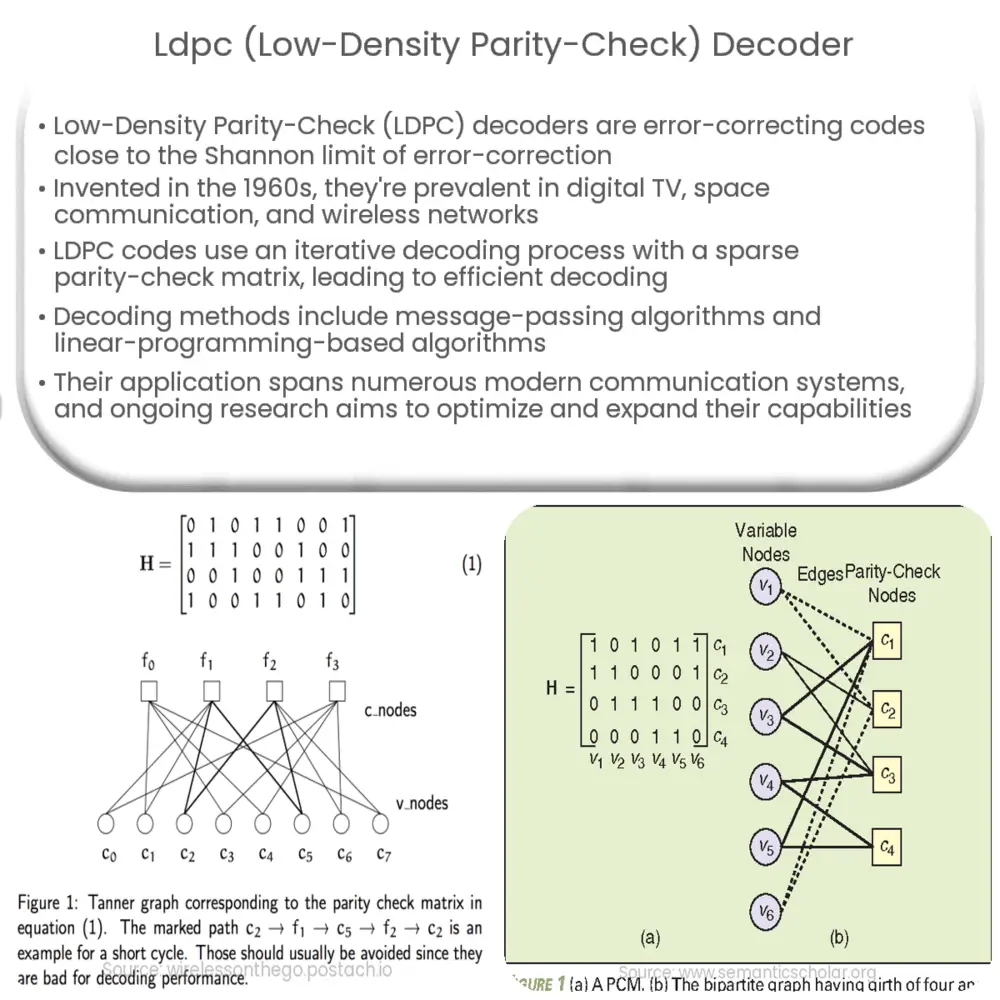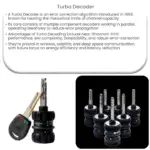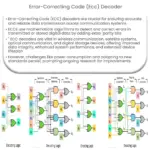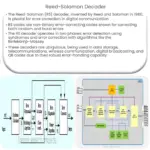LDPC decoders provide near-Shannon-limit error-correction in communication systems, such as digital TV, deep space missions, and wireless networks.

Introduction to LDPC (Low-Density Parity-Check) Decoders
Low-Density Parity-Check (LDPC) decoders are a class of error-correcting codes that have gained popularity in recent years due to their ability to approach the theoretical limit of error-correction performance, known as the Shannon limit. Invented by Robert G. Gallager in the early 1960s, LDPC codes have found applications in a wide range of communication systems, including digital television, deep space communication, and wireless networks.
Overview of LDPC Codes
LDPC codes are linear block codes defined by a sparse parity-check matrix. This matrix consists of a small number of ones and a large number of zeros, giving it a low density. The sparsity of the matrix leads to efficient decoding algorithms that can handle a large number of iterations with low computational complexity.
One of the key features of LDPC codes is their iterative decoding process, which is based on the belief propagation algorithm. The decoder uses soft information, i.e., probabilities or likelihoods, rather than hard decisions (bits) to correct errors in the received message. This iterative process, along with the sparse structure of the parity-check matrix, enables LDPC codes to achieve near-Shannon-limit performance.
Decoding Algorithms for LDPC Codes
There are two main classes of decoding algorithms for LDPC codes: message-passing algorithms and linear-programming-based algorithms. The most widely used message-passing algorithms are the Sum-Product Algorithm (SPA) and the Min-Sum Algorithm (MSA). These algorithms are designed to provide a trade-off between complexity and performance, with SPA offering better error-correcting performance at the cost of higher complexity, and MSA offering lower complexity with slightly worse performance.
Linear-programming-based algorithms, on the other hand, provide a different approach to decoding LDPC codes. These algorithms leverage the power of linear programming to find an optimal solution for the received message, which results in a potentially improved error-correction performance. However, this approach generally requires a higher computational complexity compared to message-passing algorithms.
Applications of LDPC Decoders
LDPC decoders have found wide-ranging applications in modern communication systems due to their near-Shannon-limit performance and low complexity. Some of the most common applications include:
- Digital Television: LDPC codes are used in the DVB-S2, DVB-T2, and DVB-C2 standards for digital satellite, terrestrial, and cable television, respectively, providing improved error-correction performance and reduced power consumption.
- Deep Space Communication: NASA has adopted LDPC codes for deep space missions, including the Mars Reconnaissance Orbiter and the New Horizons mission to Pluto, to ensure reliable communication over long distances and challenging environments.
- Wireless Networks: LDPC codes are employed in the IEEE 802.11n and 802.11ac standards for high-speed wireless local area networks (WLANs), enabling robust communication in the presence of interference and fading.
FPGA-based and ASIC-based LDPC Decoders
LDPC decoders can be implemented using various hardware platforms, such as Field-Programmable Gate Arrays (FPGAs) and Application-Specific Integrated Circuits (ASICs). FPGA-based LDPC decoders offer flexibility and reconfigurability, making them suitable for prototyping and testing new LDPC code designs. ASIC-based LDPC decoders, on the other hand, provide higher performance and lower power consumption, making them ideal for mass production and integration into commercial products.
Challenges and Future Directions
Despite the impressive error-correction capabilities of LDPC codes, there remain some challenges and areas for future research:
- Decoding Complexity: While LDPC decoders are generally more computationally efficient than other error-correcting codes, further optimization and reduction of decoding complexity remains an area of active research, especially for high throughput applications.
- Finite Length Performance: LDPC codes achieve near-Shannon-limit performance for large block sizes, but their performance degrades for shorter block lengths. Researchers are exploring techniques to improve the performance of LDPC codes at short block lengths, making them more suitable for latency-sensitive applications.
- Adaptive and Non-Binary LDPC Codes: Adaptive LDPC codes, which can change their code rate or structure based on channel conditions, are being investigated to enhance communication system performance. Moreover, non-binary LDPC codes, which operate over finite fields larger than binary, offer potential improvements in error-correction performance and have become an area of interest for researchers.
Conclusion
LDPC decoders have emerged as a powerful and versatile error-correction solution for a wide range of communication systems, providing near-Shannon-limit performance with low decoding complexity. As researchers continue to explore new decoding algorithms, hardware implementations, and code structures, LDPC codes are expected to play an increasingly important role in ensuring reliable, high-speed communication across various domains, including digital television, deep space communication, and wireless networks.




